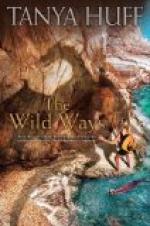But nobody cared. The zebra trooped off without turning their striped heads; the gazelle, weighted under his horns, and the gnu bull stalked away unattending; the lizards remained fixed in a permanent attitude of attention; and the snakes continued to stare at nothing. No one took the slightest notice.
Then came the reply.
It was as if a person or a thing, deep down in the bowels of the earth, hearing the bird, stirred in its sleep, and shouted up, “I come.” And it came.
Heralded by a peculiar, quaint, little, chatty, sibilant, hissing, whistling chuckle, there emerged from a regular cave that he, or an ant-bear, or some other burrower had constructed under an ancient bush, a beast—a most remarkable beast.
It was long—about three feet. It was low; it was stumpy, clumpy, sturdy, bear-like, and altogether odd. It had no ears that any one could find, and it rattled the most murderous armament of claws that you ever guessed at. But that was not all; not by any means. It, or, rather, he, had really been colored grayish white in the first place; but Nature had thoughtlessly dropped him into a vat of black paint on his “tummy,” flat, and left him there to swim about, so that by the time he got out he was one half, including chin, black, and the other and upper half, including top of head and back and top of tail, grayish white. And then, for a joke, it seemed, Nature had painted a white band round where black and grayish white met, a sort of water-line, so to speak, and let the poor little beggar go—go, mark you, into a wild where self-advertisement is something more than unhealthful for the smaller folks. Afterwards, however, Nature—who is all a woman—had repented, seemingly, and being unable to undo her own jest, had given to the little, slow, conspicuous beast, as compensation, a courage surpassing the courage of any other beast on earth. The result was rather curious—it was also the ratel, or honey-badger, who had nothing at all to do with rats, but everything to do with honey, and was self-evidently more than three-parts badger.
“Kru-tshee! Kru-tshee-chlk! Krue-tshee-chlk-chlk, whee-tshee-tse-tse, tse-i-who-o-o!” he whistled, and chuckled, and muttered, and fairly sang to himself as he came trotting along towards the cheeky little bird, like a dog that answers a whistle. His gait was all his own, as he, too, was all his own original self, being unlike anything else, although he bore the stamp of the badger people upon him.
With a calm, rolling trot, head down, tail up, back a fraction arched, with something like the slouch of his distant relation, the wolverine, he proceeded, preceded always by that dusky phantom bird that flitted and perched ahead of him, like a yellow-hammer down a country lane—calling, calling, calling. And he, lifting his odd, flat, “earless,” sleek head to it, would whistle and chuckle in reply. They had, it seemed, arrived at a perfect understanding, these two, during the centuries. “Lead on, Macduff!” he seemed to say.




